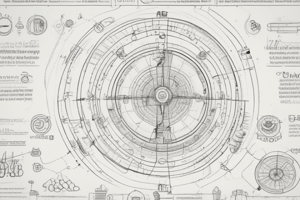Podcast
Questions and Answers
Which type of question is designed to measure the frequency of a particular behavior?
Which type of question is designed to measure the frequency of a particular behavior?
- Ranking
- Quantity
- Category (correct)
- Rating
In a ranking question, what is the purpose of leaving a factor blank?
In a ranking question, what is the purpose of leaving a factor blank?
- To indicate that the factor is the most important.
- To skip the question entirely.
- To indicate that the factor has no importance. (correct)
- To indicate that the factor is the least important.
What kind of scale does a rating question typically use?
What kind of scale does a rating question typically use?
- Nominal
- Ratio
- Interval
- Ordinal (correct)
If a researcher wants to collect precise numerical data, what type of question would they use?
If a researcher wants to collect precise numerical data, what type of question would they use?
Which type of question requires respondents to order items based on their importance?
Which type of question requires respondents to order items based on their importance?
What is the first stage in the designing of a questionnaire, according to the provided content?
What is the first stage in the designing of a questionnaire, according to the provided content?
Which type of validity assesses whether questions can predict behavior?
Which type of validity assesses whether questions can predict behavior?
Which factor is NOT a key factor for data collection, as outlined in the content?
Which factor is NOT a key factor for data collection, as outlined in the content?
Which of the following is NOT a type of variable commonly used in research?
Which of the following is NOT a type of variable commonly used in research?
Which of the following is NOT a stage in the testing for reliability process?
Which of the following is NOT a stage in the testing for reliability process?
Which of the following is NOT a factor to consider when determining the size of a sample required for analysis?
Which of the following is NOT a factor to consider when determining the size of a sample required for analysis?
Which of the following is NOT a key consideration for constructing a questionnaire?
Which of the following is NOT a key consideration for constructing a questionnaire?
What is the key difference between open-ended and list questions, as presented in the provided content?
What is the key difference between open-ended and list questions, as presented in the provided content?
Which type of questionnaire is NOT mentioned in the content as a common method of administration?
Which type of questionnaire is NOT mentioned in the content as a common method of administration?
What is a key benefit of using pre-coded closed questions?
What is a key benefit of using pre-coded closed questions?
Which of the following is a characteristic of respondents that can influence the reliability of research data?
Which of the following is a characteristic of respondents that can influence the reliability of research data?
When designing a questionnaire, which of the following is not a core assumption to consider?
When designing a questionnaire, which of the following is not a core assumption to consider?
Which of the following does NOT contribute to the reliability of a questionnaire?
Which of the following does NOT contribute to the reliability of a questionnaire?
Which of the following is not a criterion for a well-formatted questionnaire?
Which of the following is not a criterion for a well-formatted questionnaire?
Which of these is NOT a good practice for designing a questionnaire?
Which of these is NOT a good practice for designing a questionnaire?
Why is a cover letter crucial for questionnaires?
Why is a cover letter crucial for questionnaires?
What type of research is best suited for questionnaire use?
What type of research is best suited for questionnaire use?
Which of these is NOT a benefit of using questionnaires in research?
Which of these is NOT a benefit of using questionnaires in research?
Flashcards
Questionnaire Definition
Questionnaire Definition
A tool where respondents answer the same set of questions in order.
Basic Assumptions of Questionnaires
Basic Assumptions of Questionnaires
Principles ensuring the questionnaire is user-friendly and relevant.
Importance of Cover Letter
Importance of Cover Letter
A letter that informs about research and its significance to respondents.
Types of Research for Questionnaires
Types of Research for Questionnaires
Signup and view all the flashcards
Questionnaire Format Guidelines
Questionnaire Format Guidelines
Signup and view all the flashcards
Category questions
Category questions
Signup and view all the flashcards
Ranking questions
Ranking questions
Signup and view all the flashcards
Rating questions
Rating questions
Signup and view all the flashcards
Quantity questions
Quantity questions
Signup and view all the flashcards
Survey question types
Survey question types
Signup and view all the flashcards
Respondent Characteristics
Respondent Characteristics
Signup and view all the flashcards
Sampling Size
Sampling Size
Signup and view all the flashcards
Valid Questionnaire
Valid Questionnaire
Signup and view all the flashcards
Types of Variables
Types of Variables
Signup and view all the flashcards
Data Collection Factors
Data Collection Factors
Signup and view all the flashcards
Testing for Reliability
Testing for Reliability
Signup and view all the flashcards
Open Questions
Open Questions
Signup and view all the flashcards
List Questions
List Questions
Signup and view all the flashcards
Questionnaire Types
Questionnaire Types
Signup and view all the flashcards
Pilot Testing
Pilot Testing
Signup and view all the flashcards
Question Wording
Question Wording
Signup and view all the flashcards
Data Validity
Data Validity
Signup and view all the flashcards
Closed Questions
Closed Questions
Signup and view all the flashcards
Study Notes
Questionnaire Design: Collecting Primary Data
- Questionnaires are techniques for collecting data where each participant responds to the same set of questions in a pre-determined order.
- Questionnaires should meet basic assumptions:
- Avoid unreasonable demands on respondents.
- No hidden purpose.
- Request information respondents likely possess.
- Include interesting questions.
- Avoid asking for information obtainable by other means.
Question Design
- Questions should be answerable and straightforward.
Questionnaire Format
- The presentation should be attractive, professional, and easy to understand.
- Questions and pages should be clearly numbered.
- Directions must be clear and explicit.
- Questions should be objective.
- Questions should be ordered logically.
- Use examples where necessary.
Importance of a Cover Letter
- A cover letter informs the recipient about the research.
- It establishes the importance of the research.
- It makes the recipient feel part of the research effort.
When to Use Questionnaires
- Use for explanatory (cause-and-effect) or descriptive research.
- Link with other methods (e.g., multiple-methods research).
- Gather responses from large samples before quantitative analysis.
Types of Questionnaires
- Self-administered:
- Postal questionnaires
- Internet and Intranet-mediated questionnaires
- Interviewer-administered:
- Delivery and collection questionnaires
- Telephone questionnaires
- Structured interviews
Considerations for Choosing Self-Admin or Interviewer Admin
- Respondent characteristics and access.
- Respondent biases in answers (e.g., contamination or distortion).
- Sample size required.
- Question type and quantity.
- Available resources (e.g., software).
Essential Data Collection
- Precisely defined questions (unlike in-depth interviews).
- Representative and accurate sampling.
- Understand the organizational context.
- Know relationships between variables (dependent, independent, extraneous).
- Know variable types (opinion, behaviour, attribute).
- Use a data requirements table.
Designing Individual Questions
- Adapt existing questions if necessary—always check copyright.
- Avoid misleading wording.
- Translate into other languages if needed.
- Code questions.
Questionnaire Construction
- Consider the logical order and flow of questions.
- Design a clear and user friendly layout.
Explaining Purpose & Testing
- A cover letter is essential.
- Clearly introduce the questionnaire and its purpose.
- Provide clear instructions.
- Thorough pilot testing and assessing validity are crucial.
Questionnaire Administration
- Administer questionnaires appropriate to their type (e.g., internet vs. postal).
- Internet and intranet-mediated responses.
- Postal questionnaires.
- Delivery and collection questionnaires.
- Telephone questionnaires.
- Structured interviews.
Summary of Questionnaire Usage
- Questionnaires are frequently used for descriptive or explanatory research to gather data.
- Five key questionnaire types exist (Internet/intranet-mediated, postal, delivery/collection, telephone, and interview).
- Precise research data can be gathered using a data requirements table (or similar).
Summary of Questionnaire Validity and Reliability
- Data validity and reliability, and response rate, depend on the questionnaire's design, structure, and rigorous pilot testing.
- Question wording and order, as well as the types of questions used, are very important.
- Closed questions should be pre-coded.
Summary: Important Design Features
- Clear layout.
- Logical question order.
- Easy completion of the questionnaire.
- Introduction and pilot testing of questionnaires.
- Appropriate administration method for each questionnaire.
Studying That Suits You
Use AI to generate personalized quizzes and flashcards to suit your learning preferences.




